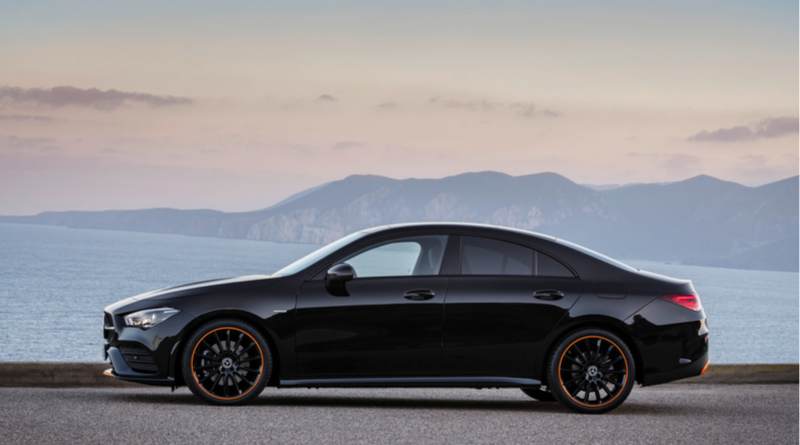You see, Japanese manufacturers in general love their rev-happy NA engines and have amassed great joy in extracting power from them. Honda had the most success until they had to visit the dark arts of forced induction with the Type R.
NA tuning can only take you so far before you run out of displacement. With turbo’s you can get away with virtually anything.
Turbo is the way to go
The Suzuki Swift Sport falls in the latter category simply because its method of attaining power wasn’t the most effective around. Each of Suzuki’s previous Swift Sport models employed naturally aspirated 1.6-litre engines, which is all good and well, but if you want to be in the conversation with the big boys, there was little comparison to be had. It was missing a key ingredient and that was a turbocharger.
Whether it was following what everyone was doing or the boardroom wanted something to compete with the rest, the new Swift Sport would boast (or boost) turbo goodness. Out went the 1.6l and in went a BoosterJet 1.4l, a downgrade of sorts but improvements to the suspension and a chassis weighing 970kg, you had one potent performance car.
Boost, boost and more boost
Once you’re behind the wheel you just want to hit boost each and everytime – its such an enjoyable experience when it kicks in from as low as 2300rpm. Gearshifts from the 6-speed manual gearbox is slick and you can easily find yourself at the 120km/h mark in 3rd. It’s worth noting that the Swift Sport only pushes out 103kW and 230Nm but damn it feels faster and that is in large part down to the turbo.
READ | Shine bright like a Starlet
It makes considerably less kilowatts than a Polo GTI for instance but this car was put together in such a way that you can give it horns around a track and still hold its own in a straight line. Not bad for a little 1.4.
Yes it makes 3kW more than the previous generation but the difference is in how it performs. If you’re not careful, you could very well be a few car lengths behind from the launch because this thing goes like it has something to lose.
It doesn’t look bad either with mean-looking headlight LED’s offered as stock. The 15-inch polished wheels could have been better designed but it serves a purpose in how the car performs. Inside is pretty much Plain Jane with the only difference being the ‘Tombstone’ sport seats, infotainment touchscreen and red touches in and around the centre console.
Suzuki have concocted a formula that works. Its bread and butter is its smaller cars, but they now have a strong performance hero to look up to.
]]>The game, as well as technology in general, has advanced a great deal since the 90’s when the first game was released. Each game is an improvement over the last one and Sport showcases the true epitome of competitive racing.
Strictly online
So first things first, the entire game is online-based and requires an internet connection to take part in online races and campaign modes. If that is not a problem for you, get ready for racing like never before.
READ | The lockdown is actually a blessing for petrolheads
Whereas passing various license tests used to be a requirement to take part in certain race events previously, in GT Sport it is merely a contributor towards the game’s overall completion. Needless to say, it is very easy to achieve a gold rating in each event.
Once you purchase your first car, you have the option of taking part in either Time Trial, Campaign, Sport and Arcade modes. There is also a Lewis Hamilton Time Trial Challenge that can be purchased from the Playstation Store. Campaign mode is where you will be spending most your time and follows the same blueprint as previous games by allowing players to participate in races that meet specific criteria.
Immersive experience
Your driver level goes up with each race completed and go high enough and you’ll unlock the next selection of races. Whereas cars used to be performance tuned by spending money, here you use mileage points that is awarded after each win. Another cool feature is the ‘distance driven’ reward. After you complete a set kilometre amount, a gift car is awarded to you.
As far as gameplay mechanics are concerned, the guys at Polyphony Digital have outdone themselves. From how a car behaves in the rev range to the sound the tyres make when tackling a chicane have vastly improved. You can even toggle things like the track map and fuel usage during the race.
The cars themselves are exquisitely designed and for the first time in the series, Porsche no longer uses the name RUF. It is its own brand. Sport mode sees you go up against races across the world and monitored by the FIA as well. In this mode it is all about racing clean, where you obtain driving points for how well you race against online opponents.
A small downside to the game is that there is no real urgency for progression. You often end up racing only to meet the distance criteria to obtain a gift car. There are no special gifts for completing a race event like in previous games.
Many will compare GT Sport to Forza on XBox One and with good reason because both games are brilliantly made. With that said, they are racing games that operate from an entirely different blueprint. Gran Turismo Sport proves that you don’t need to change a game’s philosophy to become great.
]]>Toyota, one of the biggest automakers in the world, had the Supra in its line-up up until the turn of the millennium, but primary objectives forced the carmaker’s hand to halt production on it. Various factors played a role in that decision and so closed the final curtain. Only thing is, it wasn’t the final curtain because the Supra returned with a vengeance.
A major factor that made the Supra’s return possible was Toyota’s partnership with BMW. Or part-sharing agreement, if you will. The agreement allows Toyota to use the BMW Z4’s underpinnings as the basis for its Supra, but also that the Supra borrows an interior from BMW. Does this mean that the Supra is a rebadged Z4? It sure would come across as such, but fortunately, it’s not.

BMW interior? What?!
Toyota has been producing beautiful and practical interiors of late – think Corolla. But on the 2019 Supra, it’s not the case. The Japanese automaker borrowed more from BMW than just the engine. The dashboard, complete with dials and buttons, is BMW’s previous-generation interior. Even the buttons on the steering are BMW’s.
Other interior bits worth noting is the access area behind the seats. This allows easy access to the cargo area, but, admittedly, the hole is rather big. You almost get the sense that there should’ve been a divider; even if it is just for aesthetic purposes. Regardless, the interior does exude a sense of sportiness and from the get-go, the driver is rearing to go.
The Supra’s interior may come from Germany, but it does nothing to make the car feel like an inferior product.
READ: It’s back! Toyota Supra returns to SA!
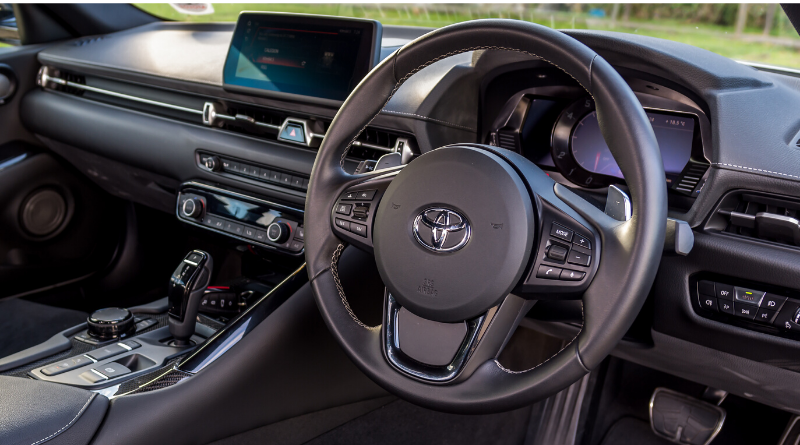
What about the engine?
In the generations preceding this fifth-generation Supra, a six-cylinder 3.0-litre petrol engine powered this Japanese sports car. The problem Toyota has now is that it does not have such an engine in its line-up to use in the Supra. And to produce one would cost millions and having it comply with emission standards… It’s a task that’ll be an unnecessary expense. Unnecessary in the sense that why research when someone else already did?
Enter BMW.
BMW builds some of the world’s best 3.0-litre six-cylinder engines and was it a natural decision for Toyota to partner with BMW. Looking across the pond, Jaguar, Mercedes-Benz, and Audi all produce six-cylinder motors, but none more renowned and reputable than BMW. The Supra shares its engine, gearbox, and chassis with the BMW Z4. In terms of the engine, the unit delivers an impressive 250kW and 500Nm. An eight-speed automatic gearbox sends power to the rear wheels, which gifts the car a nicely balanced drive.
BMW may have supplied the Supra’s heart and organs, but the personality is all on Toyota.
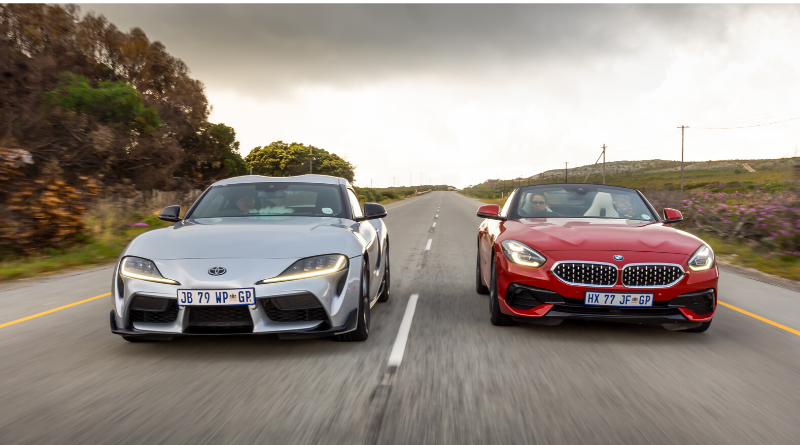
Give me more!
Deactivate DSC (Dynamic Stability Control), flick the drive mode to Sport, stamp on the brakes, feed some fuel into the engine, and wait for Launch Control to engage. Once engaged, release brakes and allow the car to hurtle towards the horizon. What a sensation! Damn, this is pretty epic! The engine roars towards the redline, slap the paddles behind the steering wheel to engage the next gear and listen to the exhaust bark.
Every gear is hooked with a menacing grip that forces you to grip the steering wheel tightly; yet with a gentleness. It’s an enticing experience that warrants successive attempts at chasing the thrill.
The Supra not only excels in a straight line. As soon as you find the car’s groove, it dances through all of your favourite bends. Sweeping bends, hard-braking ones… it all plays into the Supra’s hands. This isn’t a BMW Z4 with a hard-top roof. This is a Toyota Supra; a sports car in its own right.
The Supra needs only 4.3 seconds to go from standstill to 100km/h, and top speed is a claimed 250km/h.
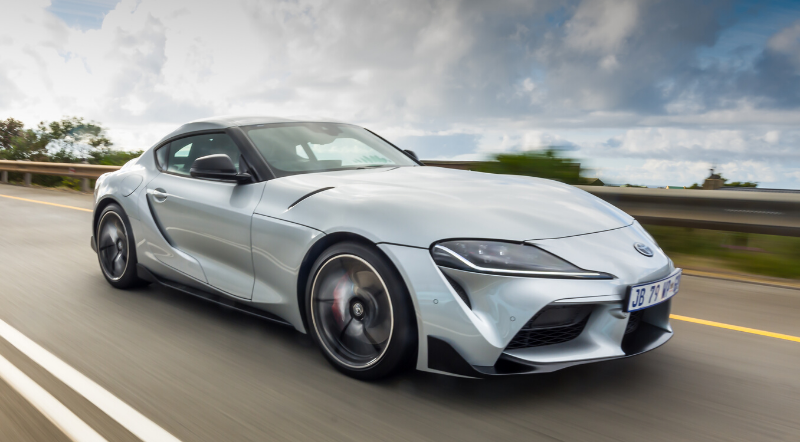
Summary
While Toyota may face some criticism for joining forces with BMW, it was a smart move on the Japanese automaker’s part. The agreement allows Toyota to tap into BMW’s technical know-how, which has a direct impact as to how its Supra carries itself on the road. In all, the 2019 Toyota Supra is a sports car that can hold its own in its segment.
I’ll admit, the interior is a bit of an overkill in terms of the part-sharing, but one can overlook it when you view the car as a whole. And when you judge the car as a whole, you can’t help but agree that this has to be one of 2019’s greatest highlights.
Price: R1 072 300

But while Volvo’s been gaining traction with both its sedans and SUVs, it’s especially with regards to the latter that the automaker has been gaining momentum. And this XC60 is one example of it. A few years ago, the second-generation XC60 was launched and almost immediately it raked in the accolades, including being named 2018 World Car of the Year. It’s a monumental feat and it showed that this SUV is not to be messed with.
The XC60 also came knocking on our door and we were all too happy to spend a few days with this champion. Dressed in the D5 AWD Inscription kit, we came to understand why the SUV is held in such high regard.
Punchy diesel engine
Nowadays, Volvo only has one capacity engine driving all of its cars, comprising both petrol and diesel, in different states of tune. In the XC60 D5’s case, power is rated at 173kW and 480Nm. An eight-speed automatic gearbox does transfer duties and sends power to all four wheels. Interestingly, the Inscription’s power delivery is very smooth and bar a little turbo lag, instantaneous. Dab the throttle and the SUV shoots forward as if nothing can hold it back.
Overtaking is a breeze too, and covering vast distances should see you reach your destination with lots of energy in toe.
What can perhaps be an issue is the amount of strain the engine is under. Forcing such impressive power figures from the engine, albeit with turbocharging, can take its toll on the fuel consumption. While Volvo rates the economy at 5.5 L/100km, our figure after a week was closer to 8.0 L. Given that the XC60 is a big vehicle, we weren’t too bothered by this figure. It was a fair return on the SUV’s part; given the mixture of peak traffic, harsh acceleration, and moderate driving.
Any electronics?
Volvo is not shy to endow its vehicles with a raft of technologies. It’s the same with the XC60 D5 Inscription; seeing that the SUV has an extensive list of standard features. Included in the price is City Safety: a detection system that identifies pedestrians, cyclists, large animals, and impending accidents. When any of the aforementioned is detected, a warning is displayed on the head-up display (HUD) and if the driver does not enforce the brakes, the SUV will do so automatically. This system might be on the aggressive, but rather this than ramming into an object. (PS: this feature was tested in a controlled environment.)
Other features include Road Sign Information Display (IDIS), Driver Alert Control (DAC) with Lane Keeping Assist (LKA), and Volvo’s new Volvo on Call (VOC).
READ: Hello, SA! Volvo On Call now available locally
What should get potential owners excited is the Pilot Assist. This optionally available semi-autonomous system, when activated, will help steer the SUV when drivers fail to do so. Veer slightly out of your lane and the XC60 will steer back into it. Around not-too-tight bends and corners, provided you’re doing a very reasonable speed, the SUV will navigate its own way around it. You can even take your hands off the steering wheel and allow the car to steer itself. However, given that this is a semi-autonomous system, users should not give driving duties over to the vehicle. The system acts as a driving support tool, and not the primary driving force. It operates at speeds up to 130km/h.
Optional extras
The Volvo XC60 D5 Geartronic AWD Inscription (to use its full name) has an asking price of R809 400, but is fitted with optional extras to the value of R153 750.
Premium Pack (R71 500) includes, but is not limited to, heated front seats, a 360° camera, a Bowers & Wilkins sound system, Smartphone integration for iPhone and Android, keyless entry and start, and 20-inch alloy wheels. Driver Support Pack (R25 750) includes the aforementioned HUD and Pilot Assist.
Other options include a Panoramic Sunroof (R19 500), Air Suspension (R26 750), and Metallic paint (R3950). The total for the individual options amounts to R56 500.
Price as tested: R963 150
To shed some light on the Corsa-range again, Opel launched a hot version of the car. Not an OPC, but a GSi version. And yes, the car is available in South Africa, as well.
The GSi name is one of those that you don’t just mention without knowing what you’re talking about. It carries a certain amount of appeal and heritage that you just don’t speak about it nonchalantly. In earlier years, the GSi badge was only used on the Opel Kadette, so it’s a bit strange to see it return on the Corsa and not the Kadette’s modern-day successor, the Astra.
Attractive body
The Corsa GSi is available only with three doors: two at the front and a third to open the boot. That immediately has an impact on how the car portrays and carries itself; quite a literal throwback to Opel’s OPC products.
At the front, the GSi boasts with an attractive face that houses a massive grille and front bumper. Atop the grille is a little horizontal opening to channel air to the engine. On either side of the bumper sits, what looks to be, two air inlets where the fog lights should’ve been. However, these inlets are just for show and do they not serve any purpose other than to be aesthetically pleasing. From the side, the car has very little to write home about, but the 18-inch wheels come to save the day with their impressive design. It sits snugly in the wheel arches and adds to the compact nature of the car.
The rear is a bit of a let-down, though. A single exhaust pipe to the left of the bumper, the spoiler, and the GSi badge are about the only giveaways that this is a special car. One would’ve liked to see a rear diffuser – even if just for some eye candy – as it would have surely added to the impression and message the car sends out.
READ: Opel Corsa 120Y: Goodbye GM, hello PSA
Access to the cabin
As expected, the Corsa does not have the biggest interior in its segment. Against the likes of the Ford Fiesta and Volkswagen Polo, it’s a rather tight space to squeeze in. And also not counting in the GSi’s favour, is the fact that this very interior has been carried over.
Every dial and knob is familiar Corsa and is there not much to differentiate it from the rest of the Corsa range. All the buttons and switchgear does what it has to, but it also highlights just how much the Corsa’s interior has dated.
It’s not all doom and gloom however, because there are some nice redeeming qualities about the cabin. For starters, the front seats are proper Recaro units. And for those of you who don’t know, Recaro makes racing seats. Slide into them, put on the racing red seatbelt, and feel how the seats fold and hug around your waste. The seats are also fitted with heaters, and the steering wheel has a warming function, too.
A set of metal pedals provide ample grip for your feet and does it add to that racing feeling.
Getting some lift
Let’s be honest: those low-profile 18-inch tyres are not the most comfortable. Every imperfection on your favourite stretch of road will bolt into the cabin. Even on our non-European national highways, the ride can at times be a bit overwhelming. But while it can be a tad uncomfortable on normal roads, the car really comes into its own when you put the hammer down on a decent road.
Disengage Eco mode and work the six-speed manual gearbox. The Corsa GSi has a turn-in that is sharp and somewhat direct, and it inspires enough confidence to know where the front wheels are and what they’re doing. Because the turbocharged 1.4-litre petrol engine sits virtually on top of the front axle, the car is not immune to understeer. Go into a corner with too much speed and the tyres will take a moment before they react to steering input. And if you’re not aware, a light tail slap (oversteer) and a lift from one of the rear wheels can catch you off-guard.
Regardless, it remains a ball of fun to drive this pocket rocket. Sending the engine’s 110kW and 220Nm to the front wheels is done via a six-speed manual gearbox. The unit’s short throw-action is addictive and modulating the clutch and accelerator for maximum fun never gets tired.
Opel claims a 0 – 100km/h time of 8.9 seconds, and a top speed of 207km/h. These figures will not headline any notice boards, but at least the driving experience will be rewarding.
Warren Wilson, Car Choice contributor and photographer, shares his thoughts.
South Africans love their fast cars and in 2019 we’ve been treated to a few of these hot hatches. Also hitting the market are lukewarm options that, in my opinion, have been welcomed with open arms. And the Opel Corsa GSi with its OPC looks is no exception.
The Corsa GSi’s ride quality is not the smoothest and you cringe every time the road surface becomes bumpy. It’s clear that this car is hard to live with on a daily basis – and something I would not use for my daily commute – but I love it for the fact that its meant to be driven on a curvy road over the weekend. Or on a tight track similar to Red Star Raceway. I mean, come on! it’s the same suspension setup from the Corsa OPC! You have to exploit it!
The 1.4-litre turbo engine is punchy, gear changes feel responsive and sporty to give you the feeling that you are driving a hot hatch and not a car that only looks the part. I’m sure people in the tuning scene will have some fun with it – I know what I would do to make just a little more “fun”.
Another party trick is those Recaro racing seats. I did, however, ask myself if these are really a necessary addition. A more affordable option could have been used to lower the asking price because frankly, R365 000 seems a tad too high. Then again, it does its job of keeping you well positioned and it’s aesthetically pleasing to look at – like the rest of the car.
During my stint with the car, I attended a breakfast drive with a few car enthusiasts. The petrol heads were taken aback with disbelief; as I was later told that they thought it was the new Corsa OPC. There was genuine interest from them. I’m sure it goes further than it being an OPC look-a-like, because the GSi badge has a rich heritage here in South Africa.
The Opel Corsa GSi is a welcome addition to our market, no doubt. But I’m just not sold on the price.
This car, available through the years in various shapes and sizes, literally ensured Honda’s survival in the 1970s and has it gone on to be Honda’s top-selling vehicle.
It’s a pretty amazing story, but the Civic, as awesome as its heritage is, is falling behind its rivals. Toyota launched its all-new Corolla in 2019. Mazda, too, came to the party with its new 3. Honda? Well, this Japanese automaker also launched a revised version of its Civic to combat the aforementioned rivals, but there isn’t much to make the Civic the proverbial cat among the pigeons.
To think, this generation Civic came to market in August 2016 but it hadn’t lived up to the expectation. The Civic does many things right, but the car stagnated while the rest of the field moved forward.
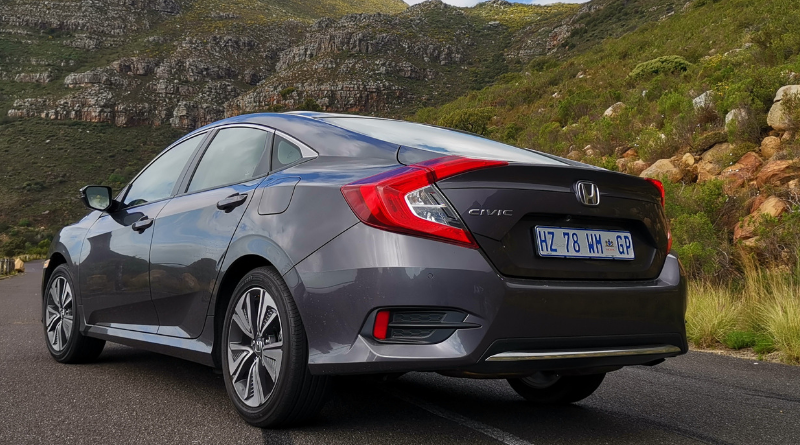
Is anything wrong with it?
At first glance, you’d be forgiven for thinking that the Civic is as fresh as milk. That it is the cat’s beard, the bee’s knees. It’s design warrants nothing less; even in this 1.8 Elegance guise. There’s just something about the car that draws you in. Perhaps it’s the sharp, edgy lines the body is adorned with. Or perhaps it’s the sporty-looking front-end.
Next to the Civic Sport, the Elegance is not as striking and can it easily become an afterthought in a sea of options. Sure, Honda can’t give the entire Civic range the best looking body kit, but the Civic needs something more to make itself relevant. To make it count.
Toyota, with its new Corolla, and Mazda, with its new 3, placed an important light on the Civic. If anything, it highlighted how far the Civic fell back in terms of its relevance. Both the Corolla and Mazda3 have a lot going for them, but the Civic has to make do with the basics. And the interior is one of the aspects that need addressing.
READ: Honda updates Civic for SA market
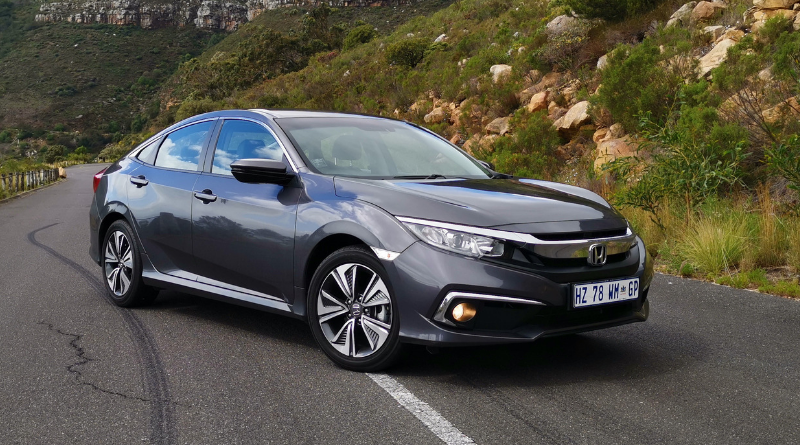
Outdated media system
If you’ve driven a Honda product in the last few years, then the Civic’s interior will not be an unfamiliar space. The manually adjustable seats are decked in leather, the switches for the seat warmers are within easy reach, and the dials on the steering wheel remind strongly of other Honda vehicles. One could even say that familiarity is key.
Ahead of the driver sits Honda’s instrument cluster. From here drivers have access to the vehicle’s status and information on the trip(s) you’re undertaking. It’s a simple but effective layout, but it does fall behind the competition. Even the screen sitting in the middle of the dashboard is not as intuitive and user-friendly as the ones used in the Corolla and Mazda3.
Operating it requires drivers to take their eyes off the road for a moment or two too long. On the rivals, the system’s readouts are easier to see and can one intuitively make a selection without having to read the full function/menu. Honda has to give its multimedia system a rethink if it wants to compete against the best the industry has to offer, otherwise, the Civic will lose too much ground.
But the Civic does win ground when it comes to spaciousness. Rear occupants have ample leg- and headroom, even when the driver’s seat has been pushed back by an unusual amount. Boot space is a generous 430L.
READ: Three Japanese rivals to the Mazda3
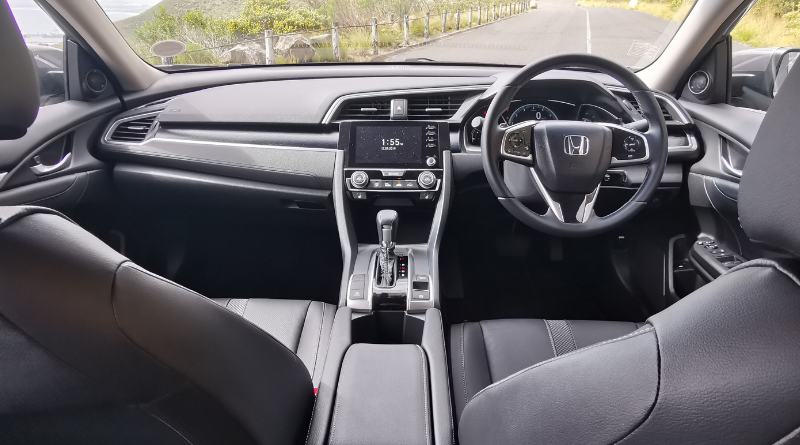
No turbo?
Well, the Civic range is not devoid of turbocharged engines. The 1.5-litre engine used in the two more expensive models is turbocharged, as well as the 2.0-litre mill doing duty in the Civic Type R. But the 1.8-litre, however, does not have any form of forced induction. This naturally-aspirated unit delivers 104kW and 174Nm of torque. And as is expected, one has to work the engine a bit to get any ideal level of performance out of it.
Mated to a Continuously Variable Transmission (CVT), the car needs about 10 seconds to go from 0-100km/h, according to Honda. Though we had no desire to test that claim, the Civic’s drivetrain did well to propel the vehicle forward. Typical of this kind of transmission, the gearbox provoked signs of frustration from the driver, but driven sedately the car, and especially the gearbox is in their element. Drivers have the option to flick the gearbox into Sport and change gears via the paddles behind the steering wheel, but all it really does is send engine revolutions into the stratosphere.
Activating Eco mode is easy, too. Just press the button next to the gear lever and see how fuel consumption improves ever so slightly.

In summary
The Honda Civic is really not a bad car. It has a great design and a wonderful ride quality, but it has fallen behind its all-new rivals. Yes, Honda did refresh the Civic earlier in 2019, but it wasn’t enough to bring the car in line with the competition.
It’s quite ironic, really. While the Civic saved Honda in the 1970s, Honda needs to save the Civic in the 2020s.
Price: R416 700
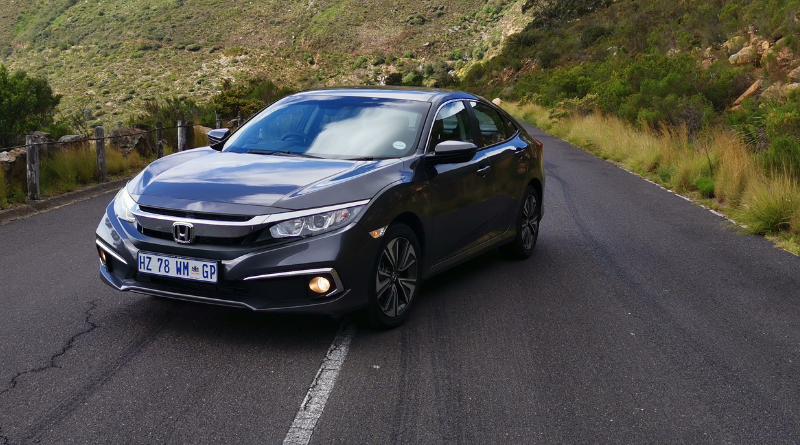
This French automaker pulled out of the South African market a few years ago and left sister-brand, Peugeot, to fend for itself. The circumstances that forced Citroën’s hand a few years ago were dire, as the automaker struggled to make ends meet and trying to stay afloat. It was tough years for both Peugeot and Citroën, and so the call was made to ax the latter from the SA.
Ironically, Citroën was performing in Europe and did they, in 2018, acquire more than 18% market share across the continent. It’s impressive, to say the least, but the success there did not spill over to South Africa. Until now.
Under the leadership of new MD, Xavier Gobille, Citroën returns to our shores and does the model line-up include three vehicles with which it hopes to lure customers again.
Citroën C3
All three of Citroën’s new models are available in two specification trims: Feel and Shine. In the C3’s case, the entry model to Citroën’s latest product offensive, both models are pretty well specified, but the biggest difference is with regards to the engine.
The C3 Feel shares its 1.2-litre three-cylinder engine with the Shine, but it has to make do without a turbo. Power is rated at 60kW/118Nm, whereas in the Shine it produces 81kW/205Nm; thanks to turbocharging. The Feel is also the only model in Citroën’s line-up to make use of a five-speed manual gearbox, whereas all the other models are fitted with a six-speed automatic unit.
At launch, we sampled the C3 Feel and what was immediately noticeable was that the little motor struggled at sea-level. The Highveld air played a big part in the car’s performance and would it take some time before there was any real response from the engine. The manual gearbox, however, has a nice, solid throw-action to it that really aided the cogging process.
Space in the C3 is somewhat limited and will larger drivers and passengers be susceptible to claustrophobia. Prospective owners are treated, however, to strong specification list in the Feel. These include: daytime-running LEDs, a bi-tone body colour, front electric windows, cruise control, seven-inch touchscreen for media, traction control, Isofix, and six airbags form part of the package. In addition, the Shine model is equipped with stop/start technology, 17-inch alloy wheels, front fog lamps, homecoming lamps, auto rain-sensing wipers, rear parking sensors, and airbump (these are protective panels on the doors to prevent an object from damaging the vehicle).
Citroën C3 AirCross
Also available in Feel and Shine trims, the C3 AirCross adopts the 81kW engine used in the C3 Shine. The engine sends its power to the front wheels via a six-speed automatic gearbox and does the two units work well together to bring about a good experience from a driver’s perspective. On the open road, the C3 AirCross had ample going for it and did it never feel as if the SUV was out of its depth.
The C3 AirCross, according to Citroën, is the most spacious vehicle in its segment and boasts with strong dimensions. It’s 4.15m long, 1.76m wide, and 1.64m tall. This all translates to a cabin that is a fair amount more spacious than the standard C3 and even the head- and elbow room sees an increase. In Feel specification, boot space is a very adequate 410L, but in the Shine, thanks to the three rear seats that can be moved forward individually, that space increases to 520L. And yes, you can fold the rear seats down, which will result in an even greater loading area.
The C3 AirCross may share its platform with the C3, but ground clearance is some 20mm higher. This does give the SUV a raised driving position, as well as a fair amount of confidence when tackling a piece of gravel. This vehicle is available in three colours: White, Platinum Grey, and Soft Sand. An additional colour pack, called Spicy Orange, can be specified, as well.
Citroën C5 AirCross
Heading up Citroën’s line-up in South Africa is the new C5 AirCross. This SUV, according to the automaker, is of the biggest in its class and boasts with impressive diameters to really set it apart. Part of that arsenal is a ground clearance of 230mm, blackened pillars at the windows, and a design that shouts French flair at the top of its lungs.
Perhaps the most striking aspect about this SUV’s design is its front-end. At the bottom, two red inserts have been brought onto the front bumper to give the SUV that immediate drawcard. Above it, the lights seem to be incorporated into the grille with a chrome strip running diagonally across. The badge has been woven into it. At the rear, two exhaust outlets have been draughted into the bumper and the rear lights have a 3D-effect about them when you switch the vehicle on.
Regarding practicality, the C5 AirCross does not drop the ball. Boot space is a very generous 520L, but increases to 720L when the rear seats have been moved forward. Fold these said seats down and boot space expands to a very healthy 1 630L.
The rest of the interior has a simple-yet-effective design and is it devoid of unnecessary dials and buttons. The layout of the multimedia system and its usability is really good and did Citroën do the most to gift the vehicle with a well-sorted cabin.
The C5 AirCross is powered by a turbocharged 1.6-litre petrol engine that produces 121kW and 240Nm. Power delivery on this unit is smooth and linear, and is the slightest throttle inputs required for the SUV to get a move on – thanks in part to all the torque being available at a low 1 400rpm.
What really does help the SUV’s credentials is a suspension setup that works really well. Making use of Citroën’s Hydraulic Cushions, the C5 AirCross has an endearing ride quality that absorbs any and all undulations on the road. Having driven the SUV on a gravel road at launch, the vehicle absorbed everything with aplomb and ensured that maximum comfort is maintained at all times.
All Citroën models are sold with Citroën Serenity, which includes a five-year/100 000km service plan and warranty.
Earlier in 2019, Mazda South Africa launched the newest version of the 3 locally and is the automaker adamant that the latest iteration will succeed, as well. The 2019 model is available in both hatchback and sedan, and is powered by two petrol engines: a 1.5-litre and 2.0-litre. The model we have here is the 1.5 Individual in sedan guise and is fitted with a six-speed manual gearbox. The 88kW and 153Nm the engine produces are sent to the front wheels, and the car has enough in the pocket to deliver a good enough ride quality.
Mazda went to great lengths to improve the car’s cabin and its feel. This Individual is decked in leather seats, electric adjustment for the driver’s seat, keyless entry, head-up display, and rake and reach adjustment for the steering wheel. The use of soft-touch materials adorns the interior and the stitched touch where the panels meet further enhances the interior’s feel. The sense of space is carried throughout and one is never confronted with the feeling that you’re cramped.
Priced at R418 800, this specific model comes up against some stiff competition from its country of birth. We look at three Japanese rivals the Mazda3 1.5 Individual sedan has to beat in South Africa.
1. Toyota Corolla
The all-new Toyota Corolla arrived locally in 2019, but this time there is no sedan in the line-up. However, the previous generation’s sedan is sold alongside the new model. In terms of the sedan, the closest model to the Mazda3 Individual is the 1.8 Exclusive. It retails for R371 100 (and R384 900 for the automatic option). It’s naturally-aspirated engine delivers 103kW and 173Nm, while a six-speed manual also sends power to the front wheels. It boasts with seven airbags, leather upholstery, and a boot space of 452L. This Corolla does have the price advantage, but only because it is, technically, a car that first came to market in 2014.
The hatchback, however, is a much newer proposition and features a turbocharged 1.2-litre engine. Priced between R346 600 and R377 500, the new Corolla undercuts the Mazda by quite a margin but it is a much closer rival to the Mazda3 hatchback.
For our opinion on the all-new 2019 Toyota Corolla, click on the link below.
2. Honda Civic 1.8 Elegance
Honda revised its civic range earlier in 2019 to bring it more in line with the competition (ie, Mazda3), but the car is showing its age against its countryman. The Civic is very well priced against the Mazda (R416 700) and boasts with an extensive list of standard features. Included in the deal are 17-inch wheels, rear view camera with park distance control, leather upholstery and heated front seats, a driving mode selector (sport/comfort), six airbags, and rain sensor wipers. It’s a strong list that only highlights the car’s value.
Powering this sedan is a naturally-aspirated 1.8-litre petrol engine, but it is, sadly, mated with continuously variable transmission (CVT). Lay on the throttle and the 104kW/174Nm the engine produces struggle somewhat to get to the tyres; thanks largely to the choice of gearbox.
Still, the Civic is one of the world’s best-selling vehicles of all time – having sold in access of 20 million units since the 1970s. If not for the Civic, Honda might not have been here today.
3. Subaru Impreza
Hiding in the shadows almost not being noticed is the Subaru Impreza. The two-model range is not setting sales charts alight, but Subaru still rates the sedan as an important vehicle in its arsenal. Priced at R392 000 for the 2.0i and R450 000 for the 2.0i-S ES, the range effectively places the Mazda3 in the middle in terms of pricing.
Using the more affordable Impreza as a reference, the Scoobie features seven airbags, keyless entry, voice control, climate control, 460L in boot space, and a naturally-aspirated 2.0-litre engine.
The engine is also mated with a CVT gearbox and produces 115kW and 196Nm. The big news: the Impreza sends its power to all four wheels. Subaru retained its famed all-wheel drive system on the Impreza, but 0 – 100km/h still takes just under 10 seconds to be completed.
The ML was an important vehicle for Mercedes-Benz and it also set the tone for more SUVs to come from Three-pointed Star. A few years ago, as more SUVs joined the line-up, the automaker changed the naming system for its SUVs, adopting the ‘GL’ nomenclature. The ML changed its name to GLE, as it falls in line with the E-Class family. The GLA with the A-Class, and GLS with the S-Class.
And the GLC? The C-Class sedan’s bigger brother? It came to market in 2015 and in early October 2019, Mercedes-Benz launched the latest iterations of this SUV in both standard and Coupé trim.
Enhanced design
With the expansion of Merc’s ‘GL’ nomenclature, the GLC has been on the market for almost five years and established itself as a stalwart product. It’s been one of the automaker’s best-selling SUVs (1.5 million units sold since 2015, globally) and it is for that reason that Mercedes can’t rest on its laurels when it comes to it.
Both the GLC and GLC Coupé feature greater emphasis on the exterior design. The lines and shapes forming the body are a lot sharper, more brute, and more striking. Especially on the Coupé, it lends the vehicle an almost distinctive exterior that will surely attract attention. Buyers have the option to specify the type of rim they want on their GLC/Coupé, all ranging from 19 to 20-inch units.
In the GLC Coupé’s case, it is characterised by a sloping roofline that stretches downwards towards the rear. The effect of this is somewhat limited rear space and a boot that is slightly smaller than the GLC’s. On the upside, the SUV does have the upper hand when it comes to aesthetics.
Improved interior and technology
Both iterations of the GLC see a much-improved interior and does it certainly push the SUV up a notch or two. The fit and finish afforded to the GLC exude a premium feel. Occupants are treated to comfortable seats, a spacious cabin, and driver aids and technologies.
Leading the technological charge is MBUX (Mercedes-Benz User Experience). MBUX allows users to activate the system by saying “Hey Mercedes” and then prompting a command for the system to execute. It can be further operated via touch or gesture control to ease the use of operation. A further boon is that the system, when the satellite navigation is activated, will automatically turn useful information into a video to be displayed on one of the two screens in front of the driver.
Further technologies finding their way to the GLC and GLC Coupé include Agility Control, Active Distance Assist and Active Steer Assist, Dynamic Select (driving modes), and Air Body Control (air suspension).
Model range
On the road
On the day, we only drove the GLC 300d Coupé and could we get a good idea of the SUV’s handling traits and driving dynamics. Powered by a turbocharged 2.0-litre diesel engine, the SUV had ample shove when power was called upon. With 180kW an 500Nm to its disposal, it was easy to get the engine in its optimal working range.
There is a little bit of turbo lag when you smash the throttle, but it’s almost immediately canceled out as the turbo’s kick in. In that regard, Mercedes-Benz worked their charm on the SUV for it to perform in a way that’s expected from a Merc.
Road holding is good too and does the Coupé have very little to no body roll. Steering feedback is more than adequate, and the ride quality has a sturdiness that inspires confidence from the driver’s seat.
In summary
The entire GLC is kitted with enough to warrant itself a serious player in the premium SUV segment. Against rivals such as the BMW X3 and X4, the GLC and GLC Coupé need their wit about them if they’re going to lead the charge and be the new segment leader.
And based on initial impressions, Mercedes-Benz did enough to make the range relevant again.
In the A-Class’ case, the car first made its appearance in 1998 and has, over the next 21 years, sold more than three million units to date. And a few years ago, when the new A-Class, as well as CLA and GLA, came to market, the trio sold in access of six million units, globally.
For 2019, Mercedes-Benz decided to not only bring the CLA to market but also the A-Sedan. At first glance, both vehicles may appear to be the same, but their purpose and positioning in the market tell a different story.
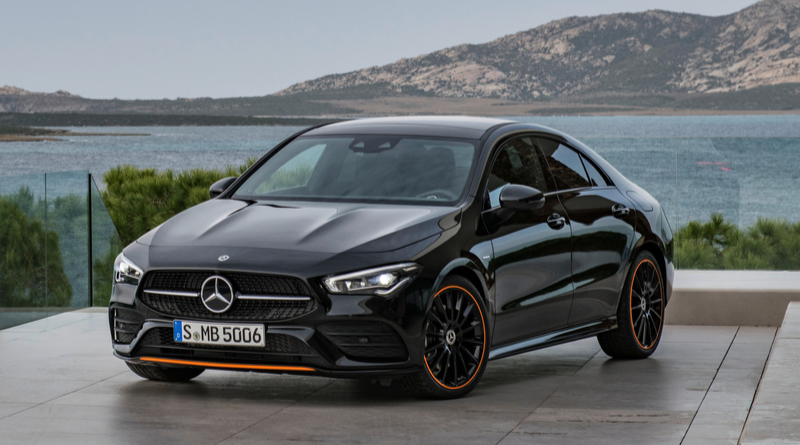
Differences, in short
The most striking difference between the two cars has to be the exterior designs. While the A-Sedan takes on a more conservative approach, the CLA is aimed at pleasing the aesthetics. The A-Sedan offers more interior room than the CLA, given the latter’s swooping roof, but the CLA has a larger boot to work with: 460L vs. 420L.
Regarding the dimensions, the CLA is slightly wider at 1999mm (+7mm over the A-Sedan), but 7mm (at 1439mm) lower than its sibling. The CLA is also sitting lower to the ground than the A-Sedan. Both vehicles share the same wheelbase, but the bigger CLA is longer than the A-Sedan.
Each vehicle has its own role to play in Mercedes’ line-up. One can be forgiven for thinking that they are essentially the same vehicle, but they’re not. And the differences are further accentuated on the inside.

Impressive tech
Both sedans adopt impressive technologies from the big daddy in Mercedes-Benz’s range, the S-Class. These technologies are especially focused on the driving side of things. The A-Sedan and CLA adopt semi-autonomous technology, Active Distance Assist Distronic that predictively adjust the speed when approaching changes in the road, Active Brake Assist, Active Lane Keeping Assist, and Pre-Safe Plus that predicts an imminent collision.
Perhaps the biggest attribution to both cars is MBUX (Mercedes-Benz User Experience). This advanced system comes complete with two tablet-like screens that display information regarding the vehicle, the trip you’re undertaking, as well as the multimedia systems in play. MBUX also allows for users to prompt a command by saying “Hey Mercedes”, which will activate the system and allow users to say a command. The system will then execute the said command.
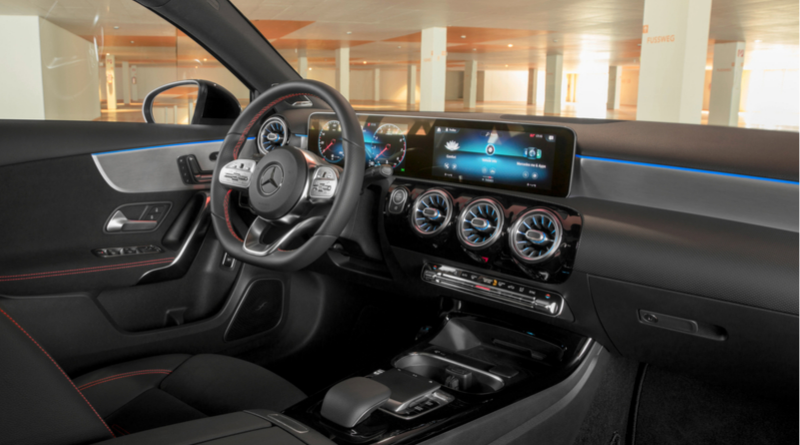
Engine choices
The cars in both ranges are equipped with two engine choices, with more said to join the respective ranges at a later stage. All engines are fitted to a seven-speed automatic gearbox.
In the A-Class sedan’s case, the A200 is powered by a 1.3-litre turbocharged petrol engine that delivers 120kW and 250Nm. This engine also does duty in the CLA 200. The A250 is driven by a 165kW/350Nm 2.0-litre engine that’s also turbocharged. In the CLA’s case, the other engine in its range is a turbocharged 2.0-litre diesel engine. This motor is good for 140kW and 400Nm, but this car’s gearbox is an eight-speed unit.
In terms of fuel economy, both the A-Sedan and CLA are fitted with a 43L fuel tank and does the automaker claim, in the CLA 220d’s case, a fuel return of 4.4 L/100km.
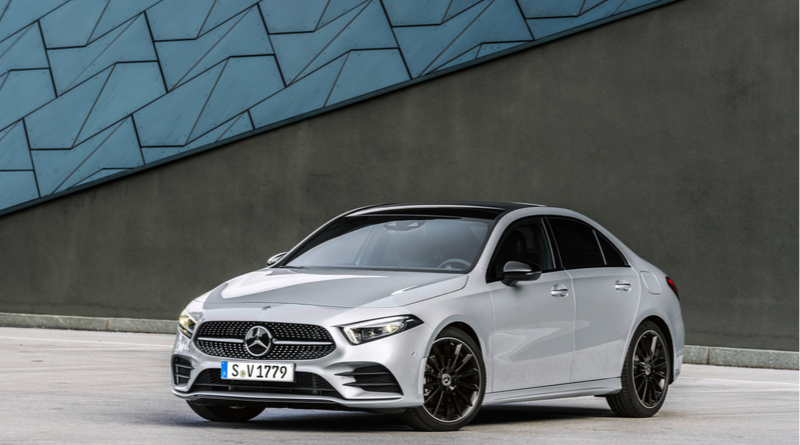
On the road
At launch, the entry-level models from both ranges were available for sampling. Though both share the same 1.3-litre engine, the differences in drive couldn’t be more different. Thanks to its increased width, the CLA has a much more composed on-road presence and does it give the driver a greater sense of confidence from behind the wheel. The A-Sedan does not fall short in any regard, but given its positioning and design, it does have a much different feel to the CLA.
Lay on the throttle and both cars react with an immediateness. The gearbox, too, cogs over decisively and is there never the feeling that either car is having problems relaying their power to the road. What is noticeable was that the sound insulation in the CLA was superior to that in the A-Sedan.
Available on both cars as an optional extra is the adjustable suspension. Fitted to the CLA, the car felt more composed on the road and did it handle undulations in the road in a much more superior manner. This optional extra should be on any potential buyer’s list, as it will undoubtedly add to the overall driving experience.

In summary
In a time where SUVs, crossovers, bakkies, and electric vehicles have become the main focus, it’s interesting to note that Mercedes-Benz is adding sedans to their portfolio. A commendable feat, because the automaker aims to serve all spheres of the market and to cater to the needs of all markets. The CLA is not unfamiliar to local buyers and it’s only right that the new generation is added. But the A-Class sedan is a different story.
Why? Because it’s a new market that’s being opened up and Merc believes that this is something that consumers will look into. Young, prospective buyers looking for their first array into Mercedes-Benz’s saloon portfolio will now have the chance to get their foot in the door with this model. It slots in below the formidable C-Class and, as a premium offering, should find favour among many.
Price:
- Mercedes-Benz A-Class sedan: From R533 906
- Mercedes-Benz CLA: From R571 006
